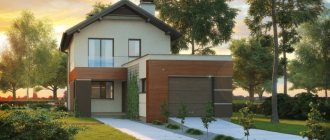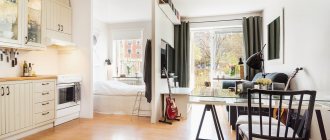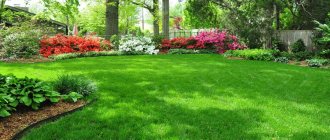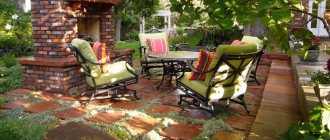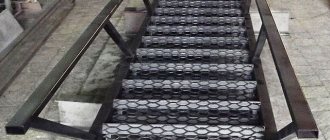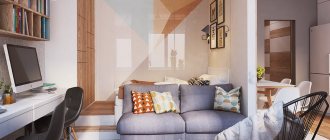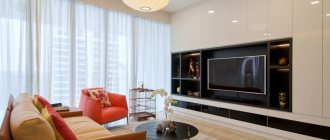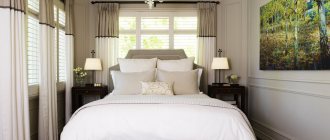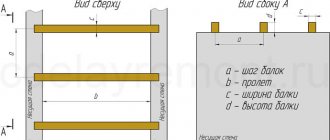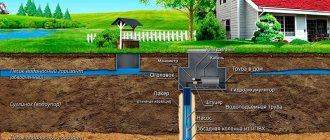Home » Articles » Buy or sell 1 hectare of land, is it possible?
- In what cases can you buy 1 hectare of land according to the law?
- The legislative framework for the purchase of 1 hundred square meters, depending on the type of permitted use.
- Is it possible to put 1 hectare of land on the cadastre? Parts of the site cannot be smaller than the size established by law. Where are they?
- Is it possible to buy one hundred? In which cases? It is possible if you want to add it to an existing plot of land. As a separate area - it is impossible.
- Is it possible to sell one hundred square meters of land?
- Is it possible to build a house on 1 acre of land? What are the requirements? 3 meters to the neighbor's fence, etc.
Is it possible to buy 1 hectare of land?
Purchasing one hundred square meters of land according to current legislation is very difficult.
Each region of the country has its own minimum plot size limits. They differ for different categories of land. So for lands belonging to such categories as: farming and peasant farming, horticultural lands, vegetable gardens, summer cottage settlements, which are in state or municipal ownership, these boundaries are regulated by the laws of the constituent entities of the Russian Federation.
Lands related to private plots (personal subsidiary plots) and individual housing construction (individual housing construction) - by legal acts of local governments. As a rule, for lands of the categories SNT, DNP, vegetable gardening and dacha settlements of various types, the minimum size is from 4-6 acres, for farms - from two hectares. For individual housing construction and personal subsidiary plots, the lower threshold starts from three acres.
Based on these data, within the framework of the law, it is not possible to purchase, sell and register a land plot of less than three acres, however, in land legislation, like in any other, there are so-called “holes”.
We are talking about such cases as, for example, shared participation, inheritance and secondary land surveying and cadastral registration of owned plots. Indeed, Article 33 of Part 1 of the Land Code clearly speaks of the primary registration of plots that are in state and municipal ownership, that is, the acquisition of land directly from the state.
This means that a plot, for example, that you inherited from your parents, together with several other members of your family, you have the full right to divide into several parts, re-do the surveying and cadastre, and then register each resulting new plot as ownership. Also, if you are the owner of a land plot of six acres, then you have every right to sell part of it, dividing it, as in the previous version, into two parts, or several, naturally formalizing this through land surveying and cadastre. Accordingly, it is also possible to buy such a plot of land using a similar scheme.
This procedure for registering the purchase and sale of small plots of land starting from one hundred square meters in size is most often used in cases of expanding existing land, for example, purchasing one or several hundred square meters from a neighbor, or from the state, if the plot does not border on neighbors and annexing it to your own.
There are, of course, simpler options for purchasing one hundred square meters of land as a property. You can always find like-minded people who do not require large land holdings and one or several acres are enough. These could be your friends, relatives, or just people just like you who are looking for options for purchasing such a plot. In this way, you can jointly buy a plot of four or standard six acres and register it as shared participation, thereby avoiding the difficult and unpleasant red tape with land surveying and cadastral registration.
Is it possible to build a house on one hundred square meters of land?
Regarding the issue of construction and registration of a house on one hundred square meters, we can only say that there are no prohibiting legislative acts in this regard, if the land has the appropriate category. The main condition for building a house is compliance with construction standards prescribed in SNiP, sanitary standards and legislative documents of the local administration. So, for example, the distance from the house to the border of the site or fence should not be less than three meters, and to the neighboring building, according to fire safety measures, at least fifteen meters for wooden houses. If your site allows you to comply with all the norms and standards specified in the regulatory documents during construction, then theoretically no problems can arise during registration, since there will be no legal grounds for this.
How to position buildings relative to the house?
For comfortable operation of a plot of 7 acres, in addition to the main house, there are additional buildings on it , each of which must be located in accordance with regulatory restrictions and meet a number of conditions:
- When placing a garage, it should be taken into account that in winter the car emits a large amount of carbon monoxide while the engine warms up. This means that, despite the comfort of residents, the parking place should be located as far as possible from the residential building.
- The bathhouse should be located in such a way as to provide a fire break between adjacent buildings. When planning a triangular or circular plot, this structure can be built according to an individual project, with non-standard corners.
- A gazebo and children's playgrounds should be installed only in places that are clearly visible from the windows of a residential building.
- Outbuildings should not interfere with the comfortable operation of the site, but at the same time, a convenient approach to them should be provided.
- If you need to organize guest rooms, you should consider the attic space above the garage.
All buildings should be connected to each other by well-lit pedestrian paths with hard surfaces. It is recommended to choose the configuration of such objects taking into account the shortest distance between the main zones. If there are a lot of turns, people begin to trample more convenient paths on their own.
Comfortable and beautiful house on a narrow plot
06/16/2016 14:57:00 | shop-project.ru | 21832 views
Distance from site boundary
A house on a narrow plot must comply with technical conditions regarding the location of the building relative to the boundaries of the land plot. A wall with a window or door cannot be located closer than 4 m from the border. There must be at least 3 meters from the “blank” wall to the border.
Architectural elements such as cornices, balconies, canopies over the entrance, terraces or external stairs are allowed to be located at a distance of at least 1.5 m from the border.
In principle, as a last resort, the house can be located closer than 1.5 m from the border, if this is taken into account in the architect’s calculations. But even in this case, the house must be located at least 3 m from the buildings on the neighboring site.
There are situations when a house is built right on the border of a plot. This may be determined by the local land use plan. The regulations also allow for the possibility of building a house directly on the border of a plot if there is already a building on the neighboring plot with a wall located on the demarcation line. In this case, however, the new home must meet certain requirements. The main ones:
- it must adhere to the existing building along the entire length of the adjacent wall,
- have a height no greater than that of the adjacent building.
Rules for choosing object placement schemes
The level of comfort during land use depends on the correct placement of the main objects - a residential building, a bathhouse, a garage, a utility unit, as well as the landscaping areas most often used in dacha construction. Depending on the configuration of the land with an area of 7 acres, the following options for locating objects are used:
- Rectangular .
The classic horizontal division scheme is suitable. The entrance group with a gate and a parking area is located along the front border, closer to the corner of the territory. The residential building is located in the center, in the front part of the site, the bathhouse and utility block are located opposite, at the opposite border. In the improvement center between capital objects it is possible to build a gazebo and a summer kitchen. - Square .
The optimal layout of the object is in the corners of the allotment. Along the front border, on one side there is a fence with an entrance group, on the contrary - a residential building, as close as possible to the neighboring territory. A bathhouse with dimensions of up to 4 x 4 m and a summer terrace, adjacent to which is a barbecue area, is being built diagonally from the main building. The outbuilding is assigned by the architect in the 4th corner of the land. As a result, a vast central space appears for the placement of all functional zones in the required proportion, according to a radial pattern. - Triangular . The correct placement of building spots for the main objects in such areas is largely determined by the ratio of the lengths of the sides of the triangle. With an equilateral scheme, it is advisable to place the residential building in the center, the garage opposite, and other structures near the sharp corners. With an uneven aspect ratio, the main object has an elongated shape and is adjacent to one of the diagonals of the territory.
- Round . Lands of this configuration are disposed to symmetrical central zoning. The main building is located at an equal distance from the fence, and the peripheral objects are located along curved boundaries, with approximately equal distances from each other.
- Polygonal . The location of objects is selected according to an individual design, depending on the geometric parameters of the territory.
When assigning auxiliary buildings, it should be noted that they should be located out of sight, closer to the rear boundary. If possible, such structures are fenced off from the general improvement area with hedges or low fences.
Optimal sizes of suburban areas
When choosing a plot to buy for housing construction, they start from its area. The universal unit of measurement is the hundredth. 1 weave is equal to 100 square meters.
The optimal size of a plot for a private house or a spacious cottage is an area of 10 to 15 acres or 1-1.5 thousand square meters. m. For a dacha or a compact country cottage, it is optimal to choose a plot of 6-7 acres or 600-700 sq. m. m.
When measuring an area, every centimeter is at stake, so it is important to set boundaries immediately after purchase and delineate your territory with a fence or conditional fencing. The exact coordinates of the site are indicated in the land documentation, which you will receive from the previous owner or from the architectural department of the local government.
Territory design development
To obtain the most accurate and visual drawing of the planning project, you must follow certain rules for preparing documentation :
The general plan of the area should be displayed not only within the boundaries of the site under consideration, but also taking into account the areas immediately adjacent to it - access roads, engineering structures, reservoirs and other objects.- All building spots and functional zones are drawn to scale in order to be able to further determine the exact distance between them.
- On each building site its area and number of storeys are indicated.
- When organizing a vertical layout, the diagram shows red and black marks at characteristic corner points, and also plots the planned horizontal lines that form the future slope of the land plot.
- If it is impossible to describe in detail an improvement element or engineering structure in a drawing, it is marked with generally accepted symbols.
- Each graphic drawing is accompanied by a table with TEP (technical and economic indicators), as well as a full explication of all marked objects in tabular form.
When ordering a complete planning project for a plot of 7 acres, the owner receives drawings with landscaping of the territory, zoning of the main elements, a consolidated plan of utility networks, as well as a vertical layout with characteristic sections along differential elevations and the balance of earth masses.
What is important to consider when building a house on a site?
You should not start construction if the boundaries of the site are not defined. Once the error is discovered, you may be required to demolish illegal buildings. This is not only moral, but also material damage.
Before construction, it is recommended to familiarize yourself with two regulations of the Russian Federation:
- Standards for designing areas with buildings of various categories;
- Regulations on garden, country and individual construction.
These papers indicate the maximum parameters of buildings on the site, the permissible area of the house, the distances between objects and the distance to the boundaries of the territory. The package of documents also contains an approved procedure for the subsequent legalization of the house. The described rules relate to fire safety, convenience and legality of site development.
Which zones should be highlighted?
With a relatively small area of 700 m2, the placement of the main objects and the functional zoning of the territory are approached with special attention. If the placement is incorrect or the balance is not maintained, it will no longer be possible to exploit such an area comfortably.
So, when developing a planning project, a specialist takes into account the following objects and landscaping elements:
- The main residential building - for a plot of 7 acres, its dimensions should not exceed 7x7 m, not counting porches and terraces. The building should be located with a minimum distance to the front boundary so that there is more space left for organizing landscaping.
- A bathhouse is an important element of hygiene and comfort in every summer cottage. The object should be placed 6 - 10 m from the main building, preferably at the far end of the site. If an open terrace is attached to the bathhouse, it can also always replace the gazebo, into which the summer kitchen is harmoniously integrated.
- A utility block , a barn, a storage room and other auxiliary buildings are needed to house a workshop, store garden tools, bicycles, rollers, fishing rods and other important items. Most often, the structure is located at the far end of the site. Its dimensions do not exceed 2 x 4 m.
- Garage - with a plot of 7 acres, a place is required to organize parking for 1 - 2 cars. Considering the small area of the territory, with a rectangular configuration, it makes sense to make this zone dependent, which does not require much space along the front border.
- Gazebo - with a square or rectangular plot, such an object is located along one of the side boundaries of the land, or in the center of the recreational area.
- An area for recreation and sports - as a rule, it is made on a lawn and is fenced off with low bushes and fruit trees.
- Vegetable garden - for placing beds on 7 acres, you should not allocate more than 60 - 80 m2. It is recommended to place all beds along the rear border of the site, between outbuildings and the bathhouse.
- Flower beds - the best solution would be to organize flower beds at the boundaries of the main functional areas, along the perimeter of outbuildings, as well as along pedestrian paths.
- Fruit trees - when placing such plantings, the prospect of their development and growth over the years should be taken into account, which requires sufficient distance between the seedlings.
When choosing small architectural forms, it is necessary to take into account the blind spots formed on the ground, which cannot be used for the placement of other objects. The location of waterfalls, artificial reservoirs or fountains in the center of a plot of 7 acres should be abandoned.
Minimum land area for individual housing construction
If you do not buy land, but take it for use on the basis of permits from local authorities, the following factors influence the size of the allocated plot:
- appointment;
- location;
- population density;
- regional rates for minimum area.
Since local authorities are responsible for the allocation of land, the rate for the allocated area may vary in different regions.
For example, in the Moscow region the minimum indicator can start from 8 acres, and in the Krasnodar Territory - from 3 hundred. The maximum land area is also determined by local government. To avoid facing restrictions after the fact, it is better to consult with the local administration before purchasing a plot.
The main law regulating the development of sites for individual construction is the Land Code. Locally, they are also determined by an additional list of documents. It is worth noting that citizens from preferential categories can receive land plots in a special manner.
Zoning
The main principle when dividing a site into zones is practicality. When developing a facility layout plan, often ask yourself a simple question: Do I really need this? Practice shows that it is quite possible to abandon certain landscape elements or allocate a smaller area for them. For example, if there is a parking lot next to the house, then building it on your own territory is irrational.
After analyzing the situation around you, proceed to zoning the space. Designers highlight the following areas for comfortable living:
- residential includes a house and surrounding area;
- recreation involves creating a sports or children's playground, installing a gazebo or organizing a barbecue area;
- the economic zone unites various outbuildings;
- vegetable garden and garden.
How to correctly calculate and find out the size of the land. plot?
When considering an application for the allocation of land, local authorities may provide the applicant with a plot that does not correspond in size to the optimal permitted use or refuse the applicant on the basis of a high request. In this case, you can achieve a fair solution in court.
You can find out the area of land that is at the disposal of the local council based on the assigned cadastral number. The cadastral number is indicated in the plot passport and can be obtained through a private request from the owner (extract from the register).
If you do not have accurate data on the parameters of the land plot, but you need to obtain this data for construction planning, you can make the calculation yourself. To do this, you can use a universal calculator. Take into account the fact that you must have clearly defined boundaries of the land plot.
Plot area calculator
As a rule, sites of strict geometric shapes are allocated for construction. Measure the exact length and width of the site in meters. Then multiply these indicators and get parameters in hundredths. For example, with a length of 20 m and a width of 25 m, 20X25 = 500 sq. m or 5 hundred.
To revise the area of land for resale or after division, it is better to call surveyors and take repeated measurements.
It is more difficult if the distances between the sides of the site are not the same, when the territory has an irregular shape or topography. In order to calculate the area of such an allotment, you can use the calculator at the link below:
This will be approximate data. Still, whatever one may say, it will not be possible to calculate the truly accurate size of a land plot on your own. Here you will need professional tools and the help of surveyors.
Professionals have modern measuring instruments in their arsenal that provide maximum accuracy in measurement. They are certified and regularly checked to prevent errors and fraud. Among the most common devices are:
- laser tape measure;
- total station;
- level;
- range meter;
- height meter, etc.
To avoid errors in the geometric calculation of the area of a land plot using geodetic equipment, specialists also use the analytical method (it takes into account unevenness, kinks and angles).
Design stages. Main nuances
A finished sketch of the site, on which all the necessary objects, decorative elements and plantings are indicated, is the final result of the design.
To draw it, imagination and artistic talent alone are not enough. First, evaluate the content of the site. Are there ready-made buildings and various plantings on the square? Are there plans to preserve them? If yes, then label these objects on the diagram first. They will set the direction of the design. If the garden area is an empty space, then start by placing a residential building. The choice of location for its construction is influenced by several factors:
- the owner’s desire to create a private atmosphere, then it is correct to place the house closer to the exit and organize a recreation area on the rear site;
- taking into account cardinal directions. Experts recommend placing tall buildings in the northern part so that they do not create unnecessary shadows during the day;
- relief of the site. High ground is the best place to build a house.
Proportions and site development planning
Having received initial data on the size of the plot and the ratio of objects, you can begin planning the development. Schematically on the plan, the area can be divided into:
- residential area;
- gardening area;
- relaxation area.
The most important development object is a private house. It should be located no closer than 6 meters from the neighbor’s, at a distance of 5 meters from the roadway and 3 meters from the side border of the site.
Location requirements are dictated by fire safety and the need to avoid shading of areas. If one wall of the house is located in an area of high humidity, the foundation may sink more and warp the wall. In addition, finishing materials will wear out quickly and this will cause considerable trouble for the owner.
It is better to collect outbuildings into a single complex and place them in the backyard. True, this does not apply to the garage. It can be placed either in the basement of the cottage or on the side of it, closer to the exit.
If the area is small, adhere to the principle of saving space and arrange objects without violating the rules, but with maximum space conservation. The best solution in planning a building is to turn to professionals who have extensive experience in arranging private areas. They will provide you with a ready-made project that can be implemented once you receive all the documents.
The plan also takes into account the laying of communications in the future. Planning ahead will help you avoid obvious mistakes that can lead to problems later. Therefore, it is best to start building a house when all permits have already been received. Determine current regulations and build in accordance with current engineering codes.
Landscape decor
The landscape design of a site will not be complete if it is not supplemented with decorative and functional elements, such as paths, hedges, street lighting, and garden figures.
Beautiful paths can make the design of the site very attractive. They connect all zones of the local area with each other, uniting them into a single composition.
Original path in landscape design Source pinterest.com
Hedges look very impressive. Their advantage is that they are functional, aesthetic and take up minimal space. But at the same time they require constant care.
Hedge in the landscape of a suburban area Source yandex.kz
Lanterns and lamps provide illumination to the area at night, and simply serve as design elements during the day. They can be very stylish and original.
Street lights in the decor of the site Source pinterest.es
Modern landscape design involves the use of beautiful garden figures, which often look like real works of art.
For reference
Since the middle of the last century, the word “weaving” was exclusively colloquial, and in document circulation and laws the term of the metric system “ar” was used. Today, in most advertisements and purchase and sale agreements, both concepts are used equally and have the same legal force, even when these documents are presented to the court.
During the Soviet era, the area of standard dacha plots that were allocated to citizens was 6 acres. On this piece of land it was possible to safely build a small house, modest utility rooms and arrange a vegetable garden. Large plots were received only by people holding leadership positions in state-owned enterprises. For the rest, an additional 100 square meters was an unacceptable luxury.
Popular elements for landscape decoration
The decor of summer cottages is divided into:
- Natural;
- Artificial.
The second includes:
- Fences, benches, paths and bridges;
- Night lights, lighting;
- Waterfalls, pergolas, pyramids and stands for climbing plants;
- Arches, sculptures, ceramic animals and gnomes.
Some of these elements are created with your own hands, while for others you need to go to specialized retail outlets. Decorating a site is a creative process, for which you will have to activate your artistic taste and imagination. Garden paths are made from wood cuts, paving stones or concrete, which is treated with a stencil imitating masonry before drying. Fences are designed and assembled independently from wood, plastic or stone. Natural elements include special structures made from living plants:
Labyrinths. A famous example is located in Versailles. "Solitaires"
This is the name given to isolated shrubs that draw attention to themselves. Backstage. Otherwise, they are also called hedges, which create a cozy corner hidden from prying eyes. Topiary
This name hides topiary shrubs and low trees.
Separately, it is worth working on the night lighting of the area. Special lamps are installed on top under the roofs of buildings, and lanterns are installed in remote areas. Lower decorative lighting is placed along the entire perimeter. Lamps are held by funny hedgehogs, gnome miners or moles looking out from decorative holes.
So what is 1 hundred square meters?
Delving into the memories of school mathematics lessons, everyone can remember that you can find out the area of a rectangle by multiplying the length by the width, and of a square: increase the side indicator by 4 times. The same method is used in life to measure a plot of land. Imagine a plot of 10 x 10 m, you can understand that 1 acre is a fairly modest plot, which is only enough for a small garden bed. When purchasing a place for a future dacha, you should accurately plan the area of the buildings and only then decide on the overall size.
One hundred square meters of land today
Every year, land prices are steadily rising not only in suburban areas, but also in the outback of the country. And there is a completely rational justification for this.
For city dwellers who want to purchase a summer cottage for recreation, 1 hectare of land is already an opportunity to be in nature and become the owner of a small vegetable garden. If financial capabilities allow you to purchase a larger plot on which you can build a house, then for many this is the limit of imagination. This is why city residents want to purchase land near the city, and, as you know, increased demand is the main criterion for raising prices.
As for land in rural areas, if used correctly, 1 hectare is a completely worthy source of income. After all, in this area you can equip not only a good greenhouse for growing early vegetables, but also build utility rooms for keeping poultry and livestock. Each of these agricultural activities has the right to exist, as it brings good income. Therefore, today the price of one hundred square meters of land is quite high, but this is not the limit, it will continue to rise.
Tips for choosing plants
One of the most important elements of expressiveness when zoning a summer cottage with an area of 7 acres is green space. When placing such natural elements of comfort, you should also adhere to certain rules:
Garden. Fruit trees for small areas should be chosen of medium size, the growth of which will not exceed 5 - 7 meters.
The best solution would be to plant dwarf apple trees and berry bushes. When choosing full-size trees, it is necessary to maintain a distance between trunks of at least 5 - 6 meters.- Flowerbeds. Flower beds in a small area should be planted in places where they will not interfere with its operation. The best place is considered to be the space in front of a residential building, as well as areas along pedestrian paths. It is recommended to plant low-growing coniferous trees or decorative bush roses along the fence line.
- Garden. If the summer resident does not pursue the goal of harvesting, he can abandon the garden altogether. When this element is a kind of pleasant hobby, at the rear end of the site it is allowed to lay out several beds with a total area of no more than 10% of the size of the territory. Also, not far from the utility block, you can organize one greenhouse with dimensions not exceeding 2 x 5 m.
- Water. The placement of an artificial pond on a plot of 7 acres should be approached with great caution. Standing water is always an active breeding area for insects. In addition, such an object takes up extra space. The best solution would be to organize a reservoir when cascading a site located on an inclined plane, as well as in the presence of dead zones in a triangular area.
The total area of green spaces should not exceed 30% of the site area of 7 acres, since if this figure is exceeded, there will not be enough space left for zoning improvement areas.
House on one hundred square meters in South Korea
Yeonnam House (deDear_ Yeonnam) in South Korea from Cho and Partners.
This modern city house was built on a plot of just over a hundred square meters in a low-rise area of Seoul for a married couple of designers.
The house has five levels in total, including a basement with a large pit and a roof pavilion with a terrace. The main structures are made of monolithic concrete, the exterior finish is made of carbonized ash. The same materials are used in the interior decoration. Despite the dense surroundings, the architects managed to establish a subtle connection between the indoor and outdoor spaces. For example, a bathroom has a skylight to “look at the sky on a sunny day while in the bath” and “listen to the sounds of rain on a cloudy day.”
Name: Yeonnam House (deDear_ Yeonnam) Location: Yeongnan-Dong, Seoul, South Korea Architecture: Cho and Partners Construction: 2017 Site area: 130 m2 Total area: 277 m2 Photo: Yousub Song
All photographs and design graphics:
